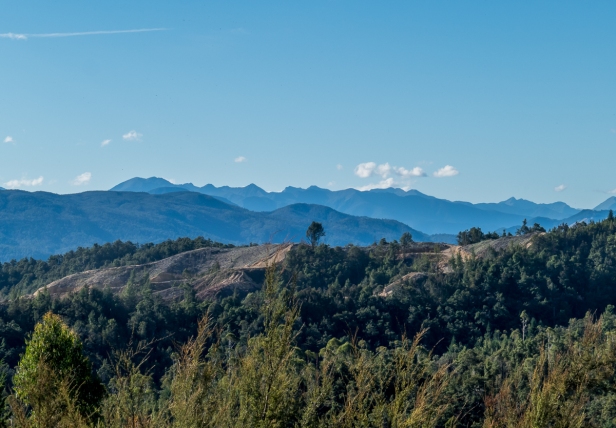
10-13 March 2015. They are right there when we get out of the car, in the car park. Most don’t notice them, or are not interested. People park their cars and walk on over to the visitor centre, but I notice them, and a couple of others do too. We follow them as they dart here and there after whatever scraps of food they can find, in and out of the surrounding thick bushes where they live, adults and chicks, seemingly unafraid with their feisty curiosity. We are at the famous Pancake Rocks of Punakaiki, and have a welcoming party of Wekas, a native New Zealand wood hen. Large, brown, flightless, and apparently rarely seen in broad daylight, we are watching several of them. Those that live near tramping huts and farms have a reputation for pilfering small objects.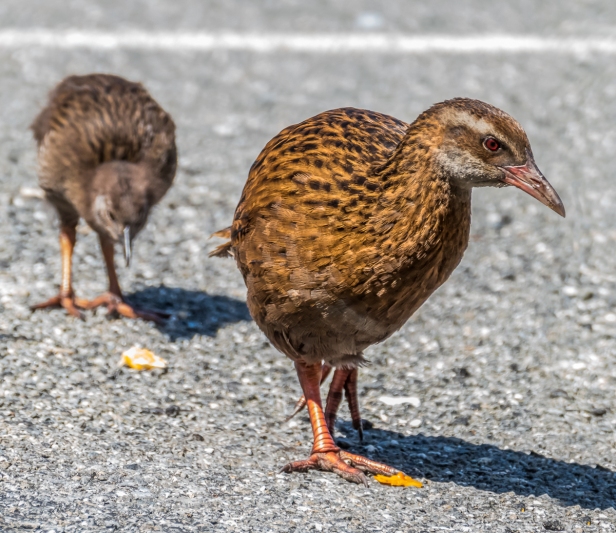
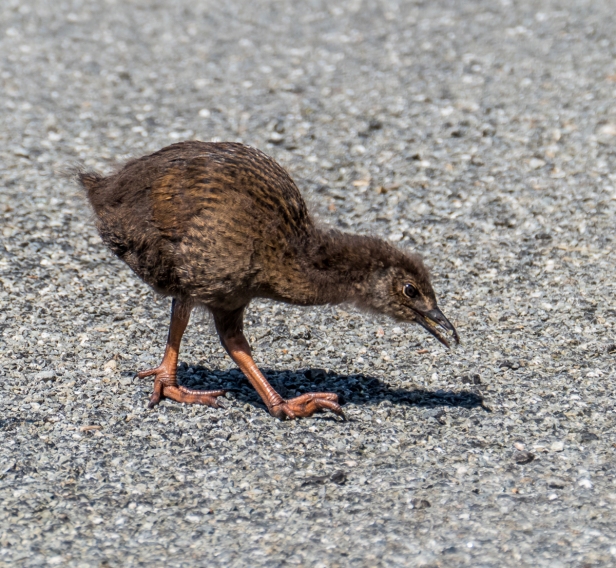
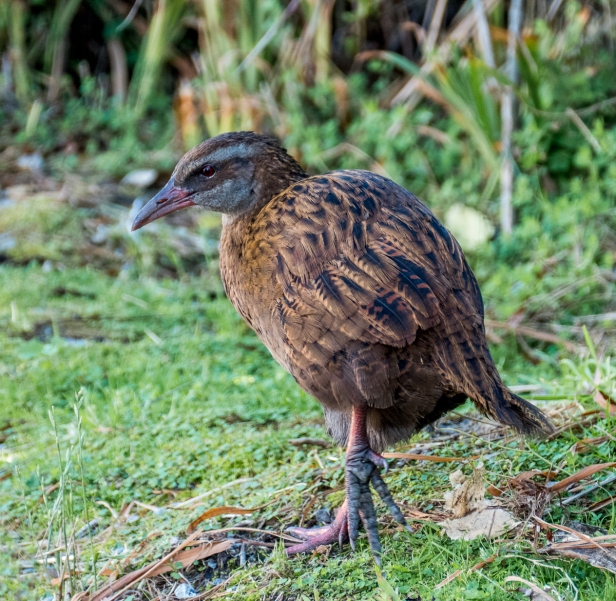
About thirty million years ago, and about two kilometres under the sea, a whole layer of tiny lime-rich fragments of dead marine creatures, skeletons and shells, landed on the seabed. Gradually over millions of years, the layer was followed by a weaker layer of soft mud and clay. Then another layer of lime-rich scraps of sea creatures, and another of mud, and on and on. It sounds scarcely believable to me. Why would all the tiny remains of dead sea-creatures land all at once? Why the layers? Wouldn’t the sea churn everything together? In this case, apparently not. All the many layers solidified under the immense pressure of the water, and then, after a few more million years, along came a giant earthquake and pushed the entire formation up above sea level where the waves have been relentlessly pounding against it ever since. Because it is mainly limestone it eroded quickly, creating one of the most unique and rugged coastlines in the world. My knowledge of geology is miniscule, but I have trouble believing in the explanations of how it was created. Everything I read about the Pancake Rocks of Punakaiki just leaves me with more questions. And pancakes? I suppose the land looks somewhat like stacks of pancakes, but whoever made these pancakes needs a few lessons. They are the most ragged looking pancakes I’ve ever seen. I suppose I was expecting them to be round. It is an extraordinary landscape, beguiling in it’s curious uniqueness. Layer upon layer, a folly of rocks, all horizontal stripes and tatters.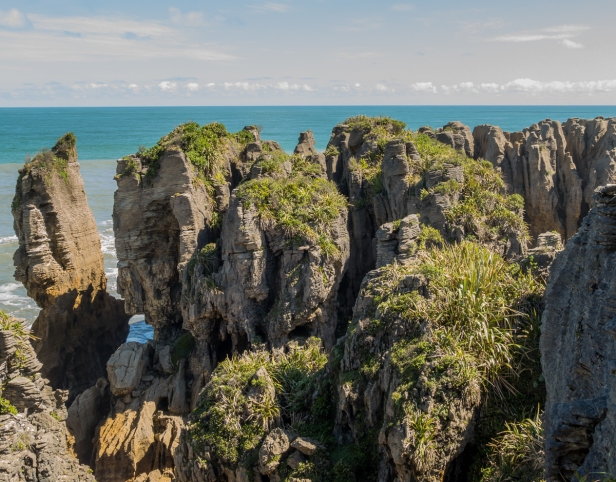

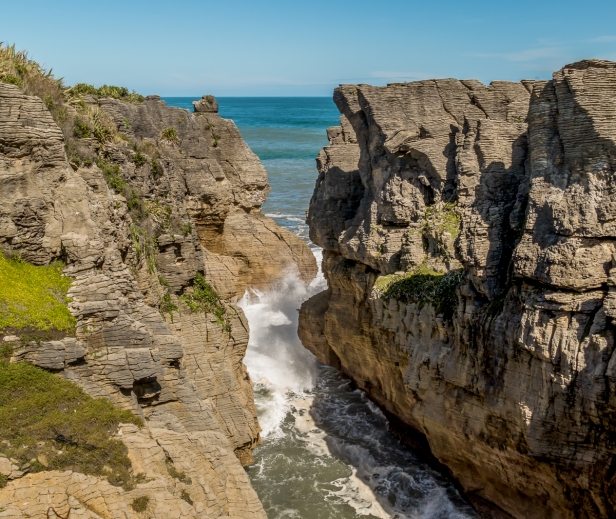
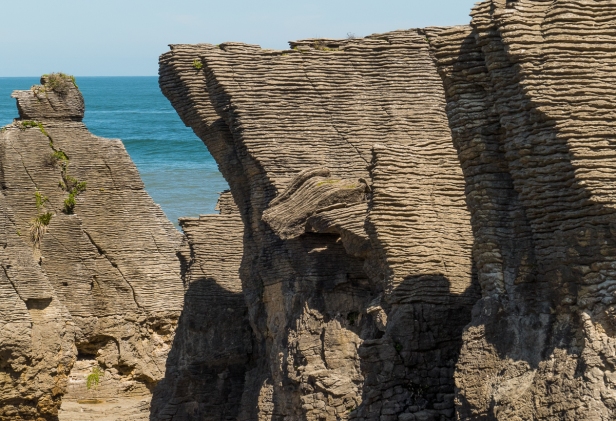
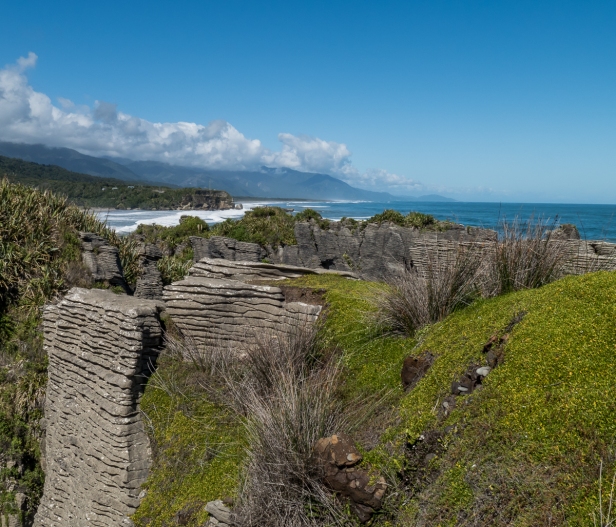
We enter into a darkened room, barely able to see even after our eyes have adjusted to the darkness. To our left is a long curve of glass and beyond it we can just make out a kind of forest, with twigs and branches, dead brown leaves and dirt. There appears to be no clear space on the ground at all. It is interspersed with small trees and ferns. Peering into the darkness, no matter how hard we try we can’t see them. We can hear them, rustling in the undergrowth, but we can’t see them. We get the woman from the front desk and she comes in with a red light and shines it into the gloom and there they are. Kiwis! Two adults and two chicks. The woman stays with us and finds them one by one. We watch them scurrying about, finding food in amongst the leaves. They have really long pointy beaks, and their feathers apparently have the feel of fur.
Kiwis! I thought they were extinct, but no. There are five species, all endangered. Although they are quite small, they are related, surprisingly, to the emu, ostrich and moa, a giant, and now extinct, flightless bird native to New Zealand. Kiwis are also flightless, and nocturnal, hence the darkened room. There is a nation wide program to save the kiwi. Adult wild breeding birds are monitored. Transmitters on the male birds indicate if an egg is being incubated since it is the male birds that sit on the eggs. Department of Conservation rangers collect the eggs and transport them to wildlife centres away from the many introduced predators. In the centres the eggs are incubated and the chicks hand raised. They are then taken to a safe predator-free environment until they weigh over one kilogram. This increases their survival rate by seventy percent.
We visited the West Coast Wildlife Centre. This is a photo of a photo from their brochure: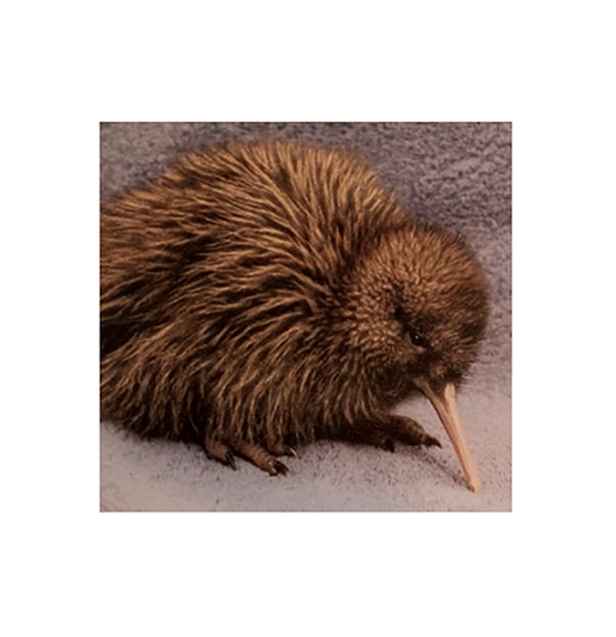
11 March 2015. From my journal: I realize I have been living in disappointment. Disappointment in myself, and in our New Zealand adventure – not enough adventure, Don’s fear of over-doing it because of his still-healing spine, always caution, no sense of freedom, always rushing because of lack of time, a quick look at this, a quick look at that, then on to the next thing, no time to really get to know New Zealand, just a quick rush through it. I see that I have been in a glass-half-empty place: not enough time, not enough adventure, too much being cautious. Putting it all on external speaker, saying it all out loud to Don, clears away the mental cobwebs and makes room for an attitude adjustment and a glorious day in Abel Tasman National Park.
Stretching along fifty kilometres of coastline at the top end of the South Island, and featuring an array of coves, granite outcrops, idyllic golden sand beaches, and numerous walking tracks, Abel Tasman National Park is New Zealand’s smallest park. What it lacks in size it makes up for in beauty.
We take a short ride in an open boat from the picturesque town of Kaiteriteri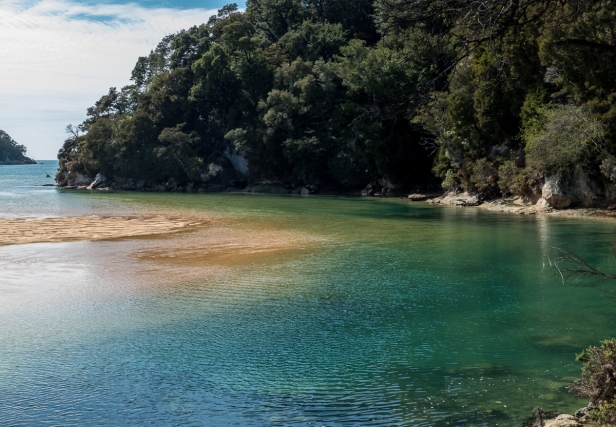
to Anchorage bay. On a dazzling sunny day we soak up the holiday feeling along with our fellow passengers.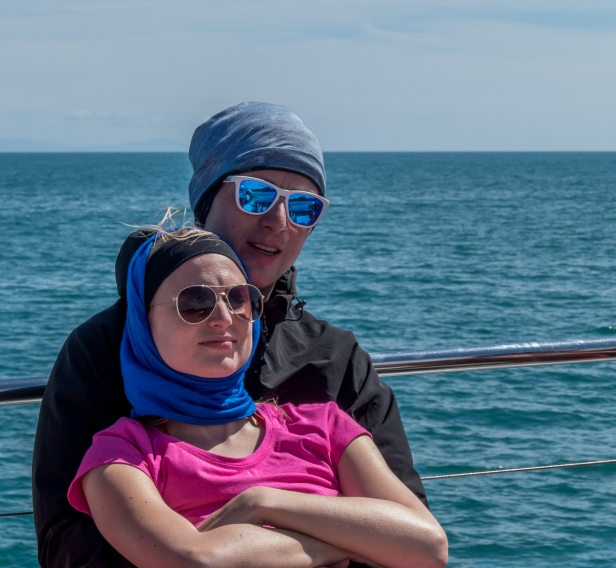
Sitting near us is a family from France. I guess the older daughter is about eight years old. French chic: they start learning from a young age.
Scenes from the boat: big sky,
and Split Apple Rock.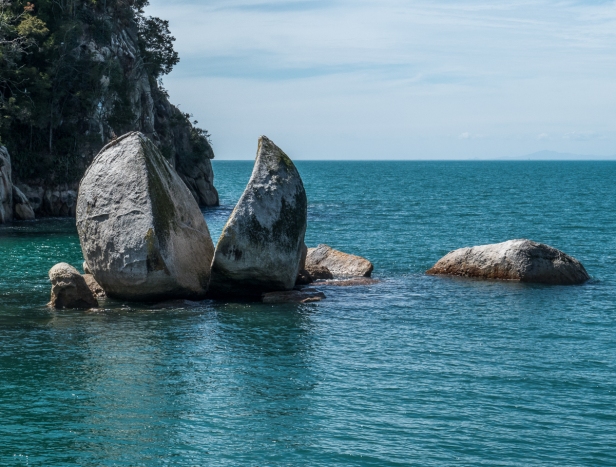
Hungry seagulls on the beach at Anchorage Bay.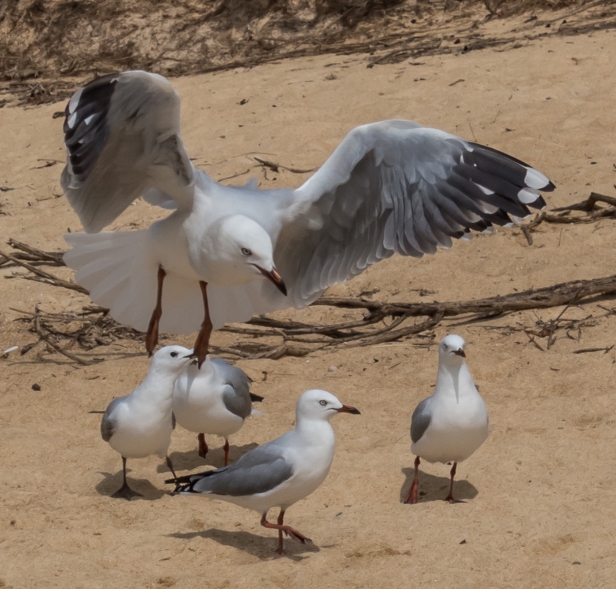
We hike along a ridge through forests of Black Beech trees and New Zealand tree ferns
out as far as Pitt Head and along the other side of the peninsula to Te Pukatea Bay.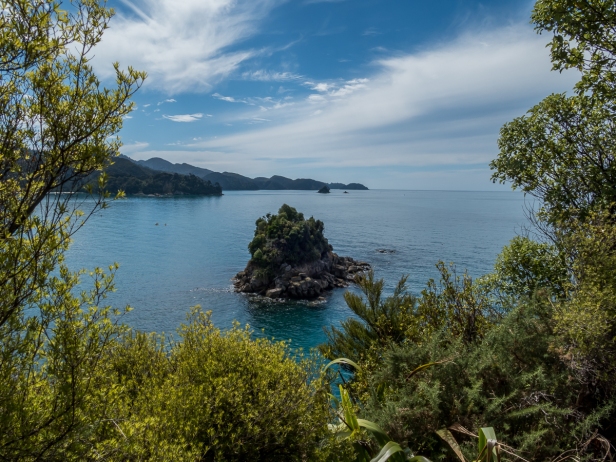
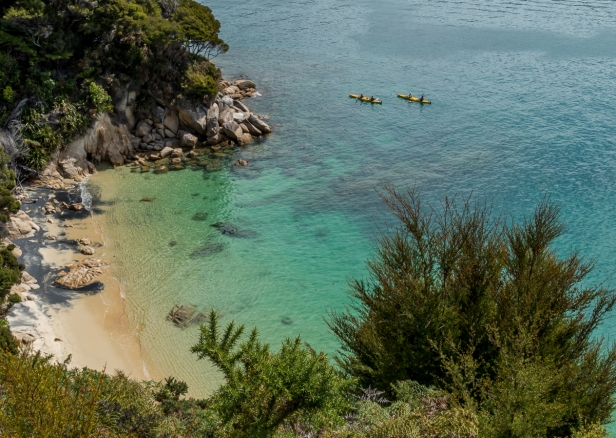
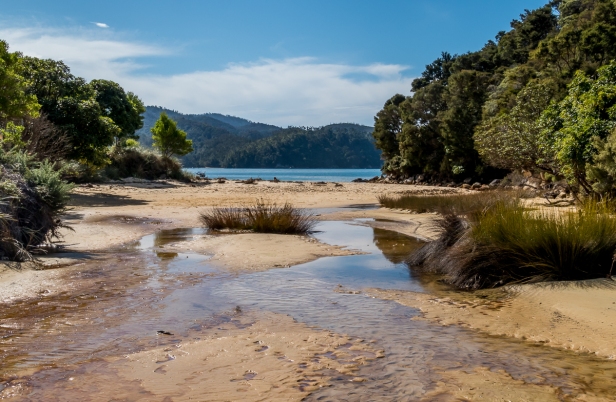
In the forest we meet the New Zealand transgender bellbird noted for having the characteristics of both sexes.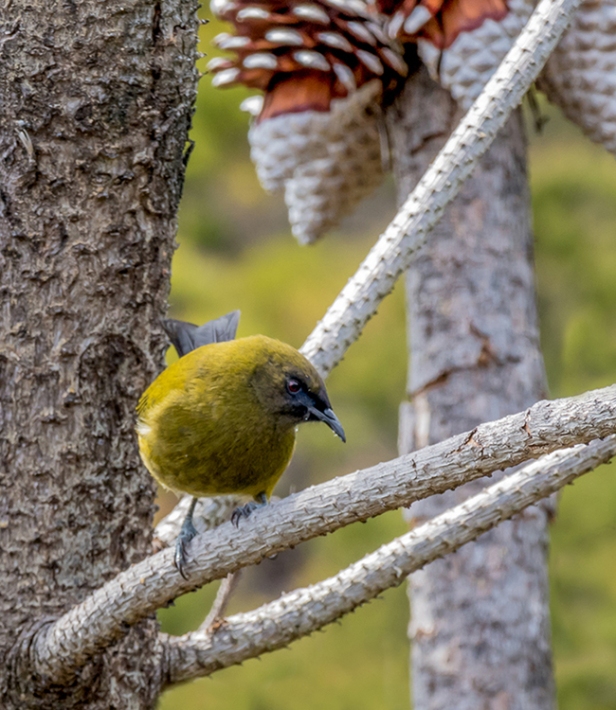
Sitting on the soft golden sand at Te Pukatea Bay eating our lunch,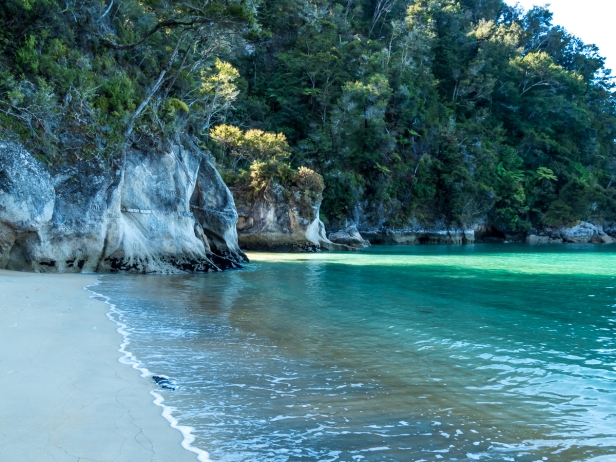
we have a long conversation with a very hungry seagull,
inhale the beauty of place, and absorb a sense of peace and tranquility, as if we are the only people on the golden shore of a tropical island. It is an easy place to sit and stare.
Continuing our journey north, the next day we drive to Picton. After three short weeks on the South Island we take an uneventful three-hour journey by ferry across Cook Strait to the North Island and a functional but utterly soulless hostel in New Zealand’s capital, Wellington. We plan a one-day stay in Wellington and fill it with a hike up to Victoria Lookout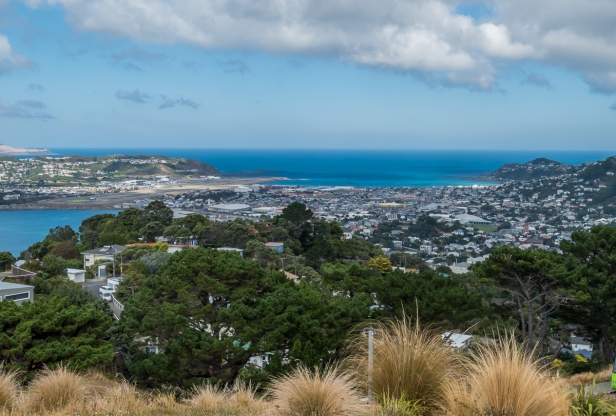
and a visit to the wonderful Te Papa Museum. In the large open foyer of the museum: a gaggle of young children resplendent in their school uniforms. It immediately takes me back to my own childhood. It’s a British thing I guess, that spread to countries colonized by the British. In Australia we didn’t wear uniforms in primary school, but everyone did in high school, and much like those pictured here – the shirt and tie, the gray tunic with three box pleats front and back, and the blazer with an emblem on the breast pocket. Children in India and Burma also wear uniforms to school, and no doubt in numerous other countries. I remember being surprised, seeing American movies in my teens, at the lack of uniforms.
But best of all in Wellington was the night market: people out playing, good food and good music. It’s Friday night and time to party.
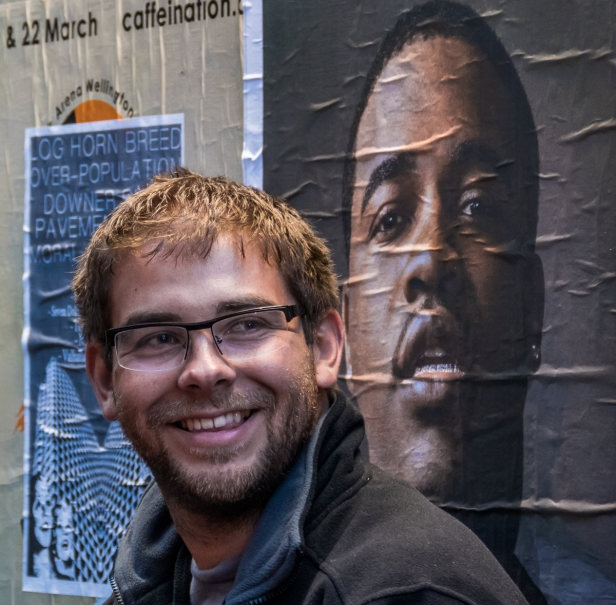
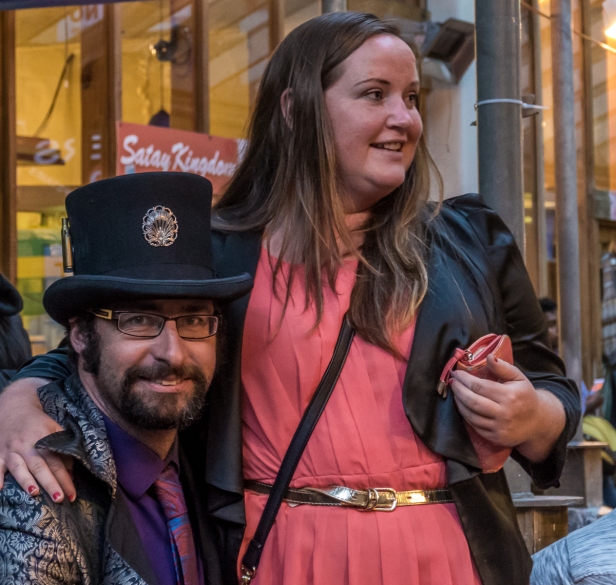
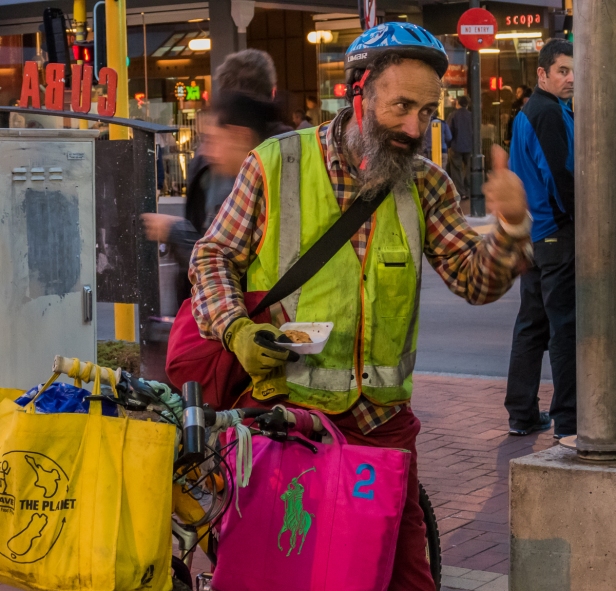
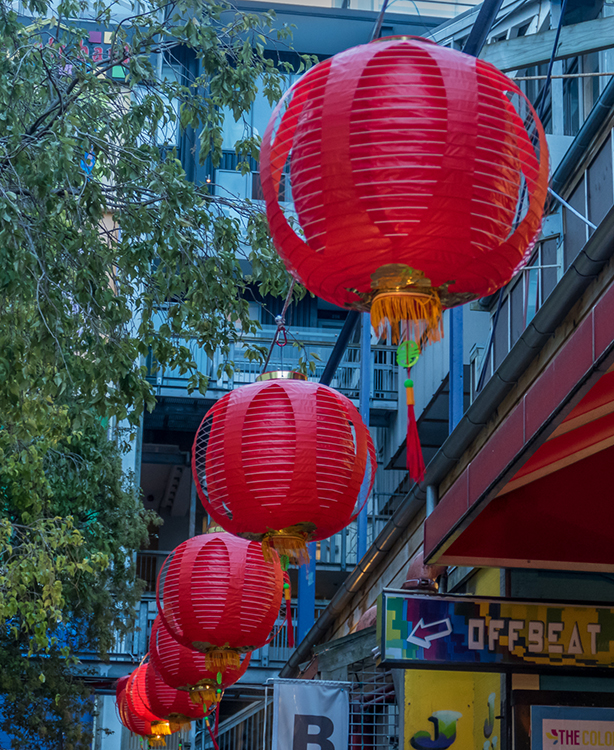



Next post: In the land of Lord of the Rings – Mount Doom and Hobbiton
All words and images by Alison Louise Armstrong unless otherwise noted
© Alison Louise Armstrong and Adventures in Wonderland – a pilgrimage of the heart, 2010-2015.

Glorious photos and commentary Alison. New Zealand is so gorgeous. Of course I’m partial to the birds. The gull squawking is a classic!
LikeLiked by 1 person
Thanks so much Cindy. NZ – endlessly stunning! That squawking gull was so entertaining. A young one I think.
Alison
LikeLike
Love those pancakes. It’s so amazing all the forms rocks, mountains and minerals can take.
LikeLiked by 1 person
Those pancakes are extraordinary. Such a strange and unusual land formation. There are amazing blowholes there but we missed them at their most spectacular because we weren’t there at high tide.
Alison
LikeLike
‘Not enough adventure’ – it’s funny how our mind works at times, but you can only experience your own life, right? Glad you worked it out. And, along the way you got some absolutely fab photos. Looking forward to your post on Hobbiton, as I am reading the trilogy right now – for the third time!
LikeLiked by 1 person
Yeah, funny how our minds work lol 🙂
We usually catch those stoopid mind stories pretty quickly. And I’m so glad I caught it because it all became much more fun after that, and having seen it once I’ll probably catch it quicker next time.
Hobbiton was delightful! Many photos to come! I think I’ve only read it once but understand the pull to read it over a again. Such a brilliant work.
Alison
LikeLiked by 1 person
Cool. I love birds. It’s strange how people just zoom on by as an ‘io (Hawaiian hawk) or pueo (Hawaiian owl) or a Kalij pheasant or a little group of Francolins flies overhead or stands by the roadside. Love that you recognize the small feathered creatures among us, and cool you saw Kiwis!
I think I’ve mentioned my daughter has traveled extensively in NZ. She says nowhere on earth is the light quite like it is there; nowhere else is that particular form of extraordinary beauty to be found.
Enjoy!
LikeLiked by 1 person
Thanks Bela. We always notice the birds, and seeing kiwis was really amazing. And yes, the light in NZ is very beautiful. I got some fabulous dawn and dusk shots along the way.
We’re now actually in Sweden visiting family. The blog is (as usual) about 4 months behind. So much to write about, so little time. Sigh. 🙂
Alison
LikeLiked by 1 person
With a post chock full of interesting activities, encounters, sights and more… what struck me most was that one paragraph of guilt for not doing more! Why is there any pressure or impatience at limitations? I fall prey to this too sometimes but also try to look at things which slow us down as a gift. Can’t be helped at times… Do hope Don is doing much better though!
LikeLiked by 1 person
Thanks so much Carissa. I must say the feeling was not guilt, but yes, it was an internal pressure. It was more to do with wanting more, a feeling like I was somehow missing out on the true NZ experience – some idea the mind had made up about what it ‘should’ be like. Nonsense of course – we had an amazing NZ experience. Once I let go it got even better mainly because I relaxed more.
Alison
LikeLike
French chic indeed!
That bit from your journal was my favorite part. The strength of the truth is something that can not be denied. Sometimes we need to have a side adventure, all by ourselves.
LikeLike
Bringing into the light the discontent that was burbling underneath was such a relief. Everything was so much better after that. I just needed to see it to be free of it.
I was so taken by that little girl. She had such a sophisticated air about her. But by the end of the day she looked like any scruffy kid who’d had a day out at the beach 🙂
Alison
LikeLike
great story and awesome images!!
LikeLike
Thank you so much. Glad you enjoyed it.
Alison
LikeLiked by 1 person
Wonderful words and photos, and, another intriguing title! Nice scenery to wake up to on an overcast and still smokey Vancouver morning. Cheers!
LikeLike
Thanks Caroline. New Zealand is full of beautiful scenery. It’s quite breathtaking and we were lucky enough to have mostly good weather.
So Vancouver’s still smokey. We’re currently visiting family in Sweden, happy to be here rather than there.
Alison
LikeLike
Lovely blog and photos, Alison and Don. I keep going back to your blog whenever I need a shot of ‘feel-good’. They are in short supply these days, but you always deliver! Thank you.
LikeLiked by 1 person
Thank you so much Helga, and I’m glad you get a shot of “feel-good”.
Alison
LikeLike
Great post. Love the bird photos. Can’t wait to see your shots from Mt. Doom.
LikeLiked by 1 person
Thanks so much Mark. I was quite lucky with the birds – they move so darn quickly!
Mt Doom coming up 🙂
Alison
LikeLike
Stunning pictures of a gorgeous country. Love the birds and the rocks and the people! Thanks for sharing. ❤
LikeLiked by 1 person
Thanks Darlene, glad you enjoyed it. Great fun taking pictures of the people at the night market. And the birds are always a good challenge.
Alison ❤
LikeLike
Beautiful photos, Alison. And re your journal entry from 11 March 2015, enjoy the adventures as small or as large as they may be, as rushed or as long. Take each day for what it is and give gratitude. Life can sometimes change in an instant (it has been one month since my husband was diagnosed with pancreatic cancer; we never saw that coming, he has never been sick). What is left of the adventures we can have together are not very big anymore. Not meaning to be morose, but I am now telling everyone to really enjoy life while you can.
LikeLiked by 1 person
Thank you so much Angeline. And yes I know you are right. We’ve lost close friends recently so we do try really hard to appreciate each and every moment. I’m so sorry for your husband’s illness. It must be a very great shock. Sending prayers.
Alison xox
LikeLiked by 1 person
Awesome post Alison…makes me want to go there..
LikeLiked by 1 person
Thanks so much Happy. I hope you get there one day, it’s a beautiful place.
Alison
LikeLike
Alison, what a treat for the eyes – and your commentary was equally engaging. I was wondering why they named it Pancake Rocks until I scrolled down to the zoomed-in photos. The resemblance is there, but you are right about them looking like badly made pancakes.
As always I loved your captures of the birds; you have such a knack for getting photos of them at just the right time! The one of the “hangry” (hungry + angry) seagull was hilarious. And in that Wellington night market – is that a stall selling Indonesian fare? I couldn’t help noticing the words “mie goreng” and “satay”.
LikeLiked by 1 person
Thanks so much James. We were quite surprised by the Pancake Rocks, expecting something quite different because of the name, but still a very intriguing landscape. I love photographing birds, partly because they are such a challenge so it’s exciting when I get a good shot. That “hangry” seagull was very entertaining! 🙂 And yes it was a stall selling Indonesian food.
Alison
LikeLike
Hard to decide which photos I love more here – the birds or the people. Luckily I don’t have to choose; they are all just fantastic! I loved your description of the Pancake Rocks and have to admit my dribbly batter and poor technique sometimes result in pancakes as ill-informed as these!
LikeLiked by 1 person
Thank you so much lexklein. Both birds and people are always fun, and challenging, to photograph. And I’m really enjoying landscape photography at the moment.
I bet your pancakes taste good though 🙂
Alison
LikeLiked by 1 person
enjoying your gorgeous photos and fascinating travelogues is always a treat. I am so encouraged to get on the stick and post some of my own travel photos…time is wasting, and the internet is. the best place to record history. 🐱
LikeLiked by 1 person
Thank you so much. I’m glad you enjoying them. Time to post your own!
Alison
LikeLike
Great photos!
New Zealand is always amazing! 🙂
LikeLike
Thank you so much. Yes, NZ *is* amazing.
Sorry I didn’t reply sooner. I just found your comment in the spam folder!
Alison
LikeLike
I so love being here with you – especially the moments so real from your journal. Your candor and confidence in your reader evokes a connectedness – a peek through your eyes and heart. xo! marga
LikeLiked by 1 person
Thanks so much Marga. I guess I like to keep it real. As all travellers know, travelling isn’t always discovery and excitement. Sometimes I get in my own way. It’s lovely to have you here, connecting.
Alison xox
LikeLike
What a wonderful post! Your photos are gorgeous! Thank you so much for sharing, and warm greetings from Montreal, Canada. 🙂
LikeLiked by 1 person
Thank you so much Linda, I’m glad you enjoyed the post.
Alison
LikeLike
What an extraordinary collection of images! I hardly know which I like best, Alison. Those weird and wonderful pancakes… the adorable kiwi…. amazing coastlines and birds galore! All of it, a feast for the eyes 🙂 Thank you for sharing these wonders.
LikeLiked by 1 person
Thanks Jo. New Zealand really is a feast for the eyes, and the camera. Seeing kiwis was pretty exciting because I never expected to, and the Wellington Friday night market a lot of fun. I’m glad you enjoyed it all.
Alison
LikeLiked by 1 person
I loved this post Alison. As always you have captured what is so unique about this glorious country. Lucky you seeing the Wekas, they must’ve been sleeping when we visited the pancake rocks. The scenery and bird photos are stunning. I’m looking forward to the next adventure.
LikeLiked by 1 person
Thanks so much pommepal. Yes, we *were* lucky to see the wekas – a little piece of serendipity, but then we’re always attracted to the wildlife. Next adventure – Mordor, Mt Doom and Hobbiton 🙂
Alison
LikeLike
That will be fun…
LikeLiked by 1 person
I was struck by the close-ups of the Pancake Rocks because the way they were stacked looked so much like the way the folds in the skin on the back of your hand stack together. Have you noticed that? I don’t think that’s at the cellular level, but more of a macro thing– the way the skin is a network of creases that allow it to easily expand and contract with our movements. These patterns in nature, and how they are repeated in such different media always astounds me…
Okay… I know it’s not a cellular thing. Here’s a cool interactive scale thingie:
http://learn.genetics.utah.edu/content/cells/scale/
May your nagging sensations of not-doing-enough dissolve forever and never return.
(Don’s, too.)
(Everyone’s…)
Michael
LikeLiked by 1 person
Hmmmm, you’ve lost me with the back of the hand thing. Wrists maybe, as you tip your hand back. But either way it’s an amazing landscape isn’t it?
The interactive scale thingy is beyond my current capabilities and available time. I’ll take you word for it that it’s cool 🙂
I seem to have let go of the not-doing-enough sensation. For now anyway. Hopefully for good.
Alison xox
LikeLiked by 1 person
I’m trying to catch up on back issues of comments (on my posts and on posts of others I try to keep up with). Yesterday I read your post on my phone will sipping a Java Chip Frappuccino in the Kuta Beach Starbucks. Photos seem more vibrant on my phone than my laptop, and today I can’t see the photos as it’s taking forever to load them on the post…Bali wi-fi.
But I remember three photos: the first photo of the bird made me stop and go Whoa. Then the photo of the kids in uniforms…such a great capture in motion, they seemed unaware of you…and that one girl’s eyes wide open. And then, the little girl from France, so chic at so young an age. Gotta love the French.
The photos are still not downloaded here on my laptop, and it’s been a good 15 minutes. But I’m left with the desire to get to NZ some day and see more than the first time, when I saw little of its beauty. I’d consider moving there if it were warmer!
LikeLiked by 1 person
Thanks badfish. The wekas were just about tame, and there were food scraps in the parking lot that had them out of the bushes – a great opportunity for photography. The school kids were unaware of me, but hard to get a good shot as they move around so much. Darn kids 🙂 and the French girl blew my mind – so much chic at such a young age. But she looked like a normal raggedy kid by the end of the day – the scarf was gone and the hair wild.
The north end of the north island apparently has an excellent climate though not exactly Bali-hot year round. NZ is definitely worth a return visit – it’s so beautiful everywhere. How did you miss it?
Alison
LikeLiked by 1 person
North end…got it. Thanks.
I was only there for a short time, always meant to get back, just never got back around to it, though I went back to OZ several times.
LikeLiked by 1 person
Hi Alison, Have been travelling so have missed your posts – just catching up now. Love this New Zealand set – looks really picturesque – a great set of shots. Te Pukatea bay looks particularly special.
LikeLiked by 1 person
Thanks so much Helen. New Zealand is really beautiful, and yes Te Pukatea Bay is definitely special. There’s an even better shot of it in this post:
Alison
LikeLike
A spectacular landscape beautifully captured in words and images Alison. And those gorgeous birds are added bonus. I hope I get to see this region in person someday. I could relate to the excerpt from your journal…I often feel the same pressure, And like you, it is when I acknowledge it and then let it go that things seem to take a turn for the ‘better’. Happy for you both that you got this glorious day to add to the many on your list. Look forward to more.
LikeLiked by 1 person
Thank you so much Madhu. Oh the mind can sure make up some nonsense! I love when I finally catch it and then can shake it loose. I have an amazing life and any complaints are just that – nonsense. New Zealand is a very beautiful and very special part of the world – well worth a visit. So glad you enjoyed the post.
Alison
LikeLike
People who have been to NZ always tell me it is the most beautiful country they have seen, and your photos and beautiful writing, have only convinced me further. How great to see the kiwi birds too.
LikeLiked by 1 person
Thank you so much Carly, and it’s true, New Zealand is truly beautiful. The kiwis were definitely a special treat.
Alison
LikeLike
We spent a wet day exploring the park with the pancake rocks. This post brought back terrific memories.
LikeLiked by 1 person
Thanks Jadi. Pretty much all through NZ we were incredibly lucky with the weather, Pancake Rocks included. What a place!
Alison
LikeLike
Wonderful post and fantastic photos! Captures the colors of New Zealand – I liked the one of the school kids at Te Papa.
LikeLike
Thanks so much Paul. We had such a good time in NZ, but discovered that 5 weeks is not enough. As I’m sure you’ve discovered, there is so much to do and see there we could have easily have used another 3 weeks. In the end we had to choose between Coromandel and Bay of Islands.
I loved the school kids – there were many of them, but this one’s the best capture I got.
Alison
LikeLike
I love your photos of the night market! So lively
LikeLike
Thanks Mo. The night market was a lot of fun. Got us our in the evening for a change!
Alison
LikeLike
Beautiful country, isn’t it?
I grew up in the no-school-uniforms U.S. but now live in the land of school uniforms, the U.K. A lot of the kids I know hate them, and I would have too. The schools and some parents argue that the uniforms are an equalizing factor–everybody wears the same thing, no matter how much money their parents have. It’s partly true, but it means the focus shifts to smaller things–shoes, backpacks, that sort of thing–and kids still get a hard time if theirs aren’t expensive enough to meet some other kid’s standards.
LikeLiked by 1 person
Gorgeous country. We loved every bit of our time there, except being horrified by how expensive it is 🙂
Kids will always find something eh? At least it’s not entire outfits. I never minded having a school uniform. Didn’t have to think about what I’d wear each day.
Alison
LikeLike